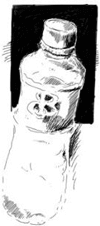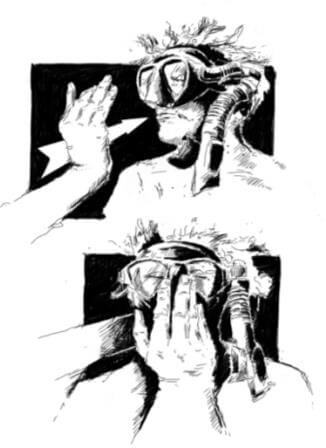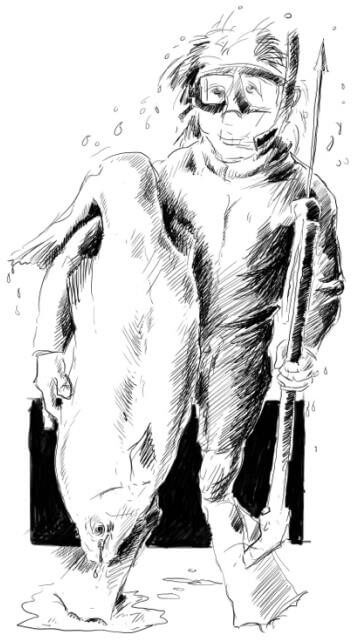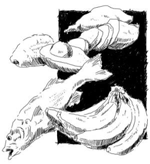 The British Spearfishing Association has kindly created this informational guide to help you get started in the world of spearfishing in a safe and informed way.
The British Spearfishing Association has kindly created this informational guide to help you get started in the world of spearfishing in a safe and informed way.
If you would like to learn more about this great organisation and get involved with fun meet ups and competitions then check out their website here: http://www.underwaterfishing.co.uk/
Introduction
This booklet is a pocket sized guide designed to raise awareness to the safety aspects of spearfishing and freediving, and is based on the advice and recommendations of both spearfishing and freediving experts with decades worth of combined experience.
The information in this booklet will help you become a safer and more competent freediver or spearfisher, and allow you to enjoy the sport more by using these tips to ensure you are in the safest situation possible.
This booklet should be used as a guide only, and is not a qualification or specific course. We recommend joining a club or completing a course where possible and dive with experienced buddies as much as possible.
To find out about courses available in your area please contact the British Spearfishing Association secretary on bsasecretary@underwaterfishing.co.uk where we can point you in the direction of recommended spearfishing and freediving courses with qualified instructors.
Before You Go Diving
Planning
Before you venture out diving you should know the venue you plan to dive including entry and exit points, what the tides are doing at that venue and if there are common rip currents. The weather should be taken into consideration and with time and experience you will learn how different winds, tides and swells affect your chosen venue. Wherever possible seek advice from locals. You should always notify someone where you will be diving and an expected time you will be back from diving. We recommend taking a phone in your car to alert someone that you will be late back if the scenario arises.
 Food
Food
Spearfishing is a very physical sport where your body will use a lot of energy whilst you are diving. It is important to eat before diving, but too much and it will impede your ability to hold your breath.
We recommend eating a small meal consisting of oats and maybe a banana, avocado or sweet potato a couple of hours before you dive.
These foods are full of good carbs producing slow release energy which is essential when spending a few hours in the water.
Hydration
 When diving your body uses a lot of water through sweating and the burning of calories to produce energy.
When diving your body uses a lot of water through sweating and the burning of calories to produce energy.
It is essential to be well hydrated before you dive, and we recommend taking a water bottle with you on your dive to help maintain hydration levels throughout your dive session.
Being well hydrated will reduce the risk of cramps, and complications such as shallow water blackout (SWB – mentioned later).
We recommend you do not dive for at least 24 hours after consuming alcohol. It can impair your judgement and dull your senses when holding your breath.
Alcohol also dehydrates you meaning your body is working harder and burning more oxygen than necessary.
Equipment
Here is a basic list of the common equipment used for spearfishing in the UK, although some setups vary in different areas in the UK, the items listed below are generally accepted as the minimum requirements to safely enjoy spearfishing within UK waters.
Fins

These are generally made out of plastic, rubber or carbon fibre/fibreglass composites. They range in length from short fins used for scuba diving to 3ft long fins for freediving and Most people start with short fins and move onto longer fins when their technique and knowledge improves.
Socks
These are neoprene and range in thickness from 1.5mm – 7mm depending where you dive and what time of year.
Wetsuit
For diving in the UK it is essential to have a well- fitting wetsuit, this will keep your body warm and allow you to spend longer in the water diving. Wetsuits work by allowing a small amount of water to get trapped between your skin and the suit. Your body heat will then warm this water, allowing you to maintain a more consistent temperature and reduce the risk of hypothermia. The best wetsuits for spearfishing in the UK are between 5mm – 7mm thick and have a hood. Most of your body heat is lost through your head so it is imperative to keep it as insulated as possible.
Dive knife

This is one of the most important pieces of equipment you need for spearfishing. It should be maintained and kept sharp, preferably with a straight edge and a serrated edge. It is used cut the diver free from ropes, nets and other snags in the water, and can be used to quickly and humanely kill the fish you shoot. The knife should be kept in a sheath and is best positioned on the inside of the calf or thigh to avoid snagging on the bottom. It needs to be accessible easily with one hand. Many divers will have a secondary knife either on the belt or weight harness as a back up.
Weights belt
These should be made out of silicone or elastic rubber, and will hold weights to help you lie still on the seabed. They are not designed to make you sink on the surface, and should be quick to release with one hand. They should be dropped and forgotten about in emergency situations. Never dive back down to recover a weightsbelt after an emergency situation, lead and rubber is not worth a human life. The weights used should ideally be 1kg weights equally spread along the belt, or 2kg weights positioned on the hips with enough to match the depths you are diving. We will cover this in more detail later on.
Weights harness/vest
This is optional, but when used should be used in conjunction with a weightsbelt. The harness is designed to spread the weights across the diver to reduce the need for lots of weights on the lower back area. It should be a quick release system that comes away from the diver effortlessly. The weightsbelt should have 75% of the total weight used, with around 25% in the weights vest/harness. This allows the diver the best chance possible of floating to the surface once the weightsbelt has been dropped in the case of an emergency.
Gloves
Whilst these are not essential they are popular in the They help prevent damage to your hands from rocks, fish spines and cold temperatures. It is important that gloves do not impede your ability to hold your speargun and press the trigger.
Dive Watch
This is a handy piece of equipment that allows you to keep track of the time, helping you to arrive home within the time you notified someone before you went diving. A dive watch allows you to see how deep your last dive was, and how long you were down on the bottom holding your breath. These are not important, and should only be checked on the surface when you have fully recovered from diving.
The most important thing a dive watch alerts the user to is the time spent on the surface between dives. This is a very important and useful piece of information and something that should be checked regularly. We recommend spending a minimum of 2x the length of your underwater time on the surface recovering, but preferably 3x the time of your dive should be spent on the surface. Repeated dives to as little as 10m, without sufficient surface time can lead to Decompression Sickness, where divers can experience tiredness, joint discomfort, itching, fatigue or skin rashes. If you show any of these symptoms leave the water and seek medical advice immediately.
 Speargun
Speargun
These generally come in two basic designs, powered by elastic rubbers, or powered by compressed air. It is illegal to use explosive devices to spear fish.
Guns vary greatly in designs and lengths. You should choose your gun to suit the area you are diving, the fish you are targeting and your ability. For areas with clearer water like Cornwall and Scotland longer guns around 90cm or longer are generally used.
In areas where the water isn’t as clear, Sussex for example, shorter guns around 60-75cm are generally used.
The speargun should never be loaded out of the water, and never attached to the diver under any circumstance in the water. If there is a safety catch on the gun this should be ignored or removed. There is no such thing as a safe gun unless it is unloaded.
Spear points should be covered with a protective sheath or rubber stopper when not in use. You should only ever shoot at something that you are certain is a fish and not attached to a buddy or buoy.
Mask and Snorkel
These are made out of a silicone outer, with tempered glass lenses. They should not allow water into the mask, and be comfortable to wear for long periods of time. When trying on a mask in the shop you should press the mask against your face and breathe in a small amount through your nose. You should feel the mask suck onto your face and you should be able to remove your hands and the mask remain on your face.
When setting the tightness of your mask for the first time we recommend you loosen the straps fully and then put the mask on, slowly adjust the tightness until the water stops entering the mask. This will prevent the mask being over tightened and causing possible headaches when diving. We recommend using a low volume mask as this is easier to equalise when diving down. You should equalise your mask whenever you feel pressure around your eyes. To equalise your mask simply blow a small amount of air from your nose into your mask.

Surface Marker Buoy (SMB) commonly known as a float
This is an essential piece of equipment. You should never dive without a float. It should be red/orange/yellow in colour and be highly visible with a blue and white flag on it. This alerts other water users to your presence in the water. It provides a platform to rest upon when tired and allows the diver to carry their catch and waterbottles, shoes and other items. It should have a small compass attached to it for use in fog and mist. The float should be connected by a length of floating line to a small weight that is quickly connected and removed to the weightbelt. The weight should be small enough to carry in one hand, and dropped to mark an area to fish such as a cave or a reef. The line should not be connected to the speargun as this allows waves to pull on the gun when aiming at fish. This could be dangerous and result in the speargun being fired accidentally. Always stay within 25m of your surface marker buoy.
Fish stringer
This is a piece of pointed metal or wood connected to a length of line. The stringer can be used to quickly dispatch the fish you shoot, but is used to keep the fish connected to your float when diving. It is not recommended to have the fish stringer attached to your belt, as it can snag on the bottom and will attract seals and other fish eating creatures, possibly allowing them to pull the diver underwater. The stringer line should not be made out of steel or anything else that cannot be easily cut through.
Things To Remember When Diving
Always dive with a buddy whenever possible.
Although the nature of the sport involves spending a lot of time alone on the bottom, many divers have been saved by a buddy within a 70m radius. Use a 1 up 1 down system, when one diver is underwater the other waits on the surface watching. When the diver surfaces and recovers the other diver dives. Always keep an eye on your buddy for signs of seasickness, fatigue, and hypothermia.
Never point a gun at anyone – loaded or unloaded.
Never shoot towards the surface.
Consult a tide card for the venue you are diving.
If in doubt consult local fishermen or the coastguard to check when slack water is and the direction of the tides. Do not end up downtide of your float or boat. If caught in a tide, never try to swim against it. Swim diagonally with it aiming for the shore.
Keep check of the weather
Try to avoid coming back into a beach at high tide in rough water. Sea breezes can increase to force 5 around mid day in hot weather. A heavy shower or squall can create its own winds that can become very strong very suddenly.
Always look up when surfacing
There could be boats, nets or other obstacles above you in the water.
Do not dive in areas of heavy boat traffic as most will not see you.
In strong currents you can use your drop weight to anchor to the bottom and hold onto your float until the tide decreases enough to swim to safety or wait until safety arrives.
Check your gear and your buddy’s gear before you enter the water, it can save a life or a wasted dive.
Avoid diving with a cold or sickness.
This can cause problems when equalising, and if forced damage the ear drum.
Equalise your ears regularly, and before you feel any pain in your ears.
Never push yourself beyond you limits.
Even if you regularly stay down for a certain amount of time you should treat every dive as a different dive. You could be tired or conditions could be different, meaning that you cannot repeat your usual performance. Learn to listen to your body. If something doesn’t feel right drop your weightsbelt and abort the dive.
If you show any signs of hypoxia or suffer a Shallow Water Blackout (SWB) – do not continue diving.
Go home and rest for at least 24 hours. No fish, depth or underwater time is worth your life.
Always remove your snorkel when diving.
If you suffer a SWB the jaw will lock around the snorkel, preventing your buddy from providing rescue breaths, and it allows water to enter your lungs.
If you shoot a fish and start surfacing, do not return to the bottom on the same breath. Resurface, recover and dive again.
When surfacing make sure the gun is pointed downwards.
If you surface and find it difficult to regain your breath, or cough up blood, stop diving immediately and seek medical advice.
Shallow Water Blackout (SWB)
Shallow water blackout is caused by the diver pushing beyond their limits and the body becoming low on oxygen. A blackout causes a complete loss of conciousness and can happen underwater or on the surface up to 30 seconds after a dive. It can come on with no warning symptoms or signs, and a freediver suffering one may not even know it has taken place.
Blackouts fall under one of 3 categories:-
- Hypoxic fit (sometimes called a Samba):- This is a loss of motor control in the body, ranging from the subtle signs such as trembling of hands, eyes twitching or removing a mask involuntarily, to the severe symptoms such as a full body convulsion. This always happens on the surface after a dive or breath hold, and can be followed by a full recovery or a blackout. Recovery breaths are vital at this point and should be performed immediately by taking a full inhale followed by a short passive exhale. This should be repeated 4-5 times.
- Shallow water blackout:- This is the total loss of consciousness, and typically happens between the surface and 10m below the surface. This area is where there is the greatest change in water pressure, which causes the lungs to rapidly expand when This causes the lungs to draw oxygen away from other parts of the body. If a diver is rescued in this situation, they are advised to leave the water where they can normally expect to make a full recovery.
- Deep water blackout:- This happens when a diver pushes themselves beyond their limits and results in a total loss of consciousness at depth. The diver will not surface if they are negatively or neutrally buoyant. There is a high risk of fatality in this situation.
Causes of a SWB
- Hyperventilation:- Any form of over breathing, either many short sharp breaths, or repeated full inhales and exhales are both classed as hyperventilation. This reduces your body’s urge to breathe amongst other things, meaning you will get less warning that you are close to being low on oxygen and blacking out, usually upon ascent as the pressure change takes place.
- Bad technique:- This will cause your body to use more oxygen.
- Stress:- Again this causes your body to use more oxygen.
- Diving when cold and tired.
- Poor recovery breaths or not spending long enough on the surface
- Overambition:- Pushing yourself too far too quickly.
- Chasing fish that are out of reach and staying down too long.
Preventing a SWB
There are things a diver can do to reduce the risk of a SWB, these include:-
- Correct breathing before diving.
- Relaxed passive breathing, followed by a full inhale before diving; or breathe for 5 seconds in followed by 10 seconds out before diving.
- Increase depth and bottom times gradually. Start off with short shallow dives to warm up, then progress to longer deeper dives to give your Mamallian Dive Reflex time to kick in.
- Don’t dive with a cold, when you are tired, dehydrated, stressed or ill.
- Relax when you dive.
- Slow down your ascent when resurfacing in the last few metres. Your legs are big powerful muscles that use a lot of oxygen, use the buoyancy of your suit to bring you to the surface for the last few metres. If you are down deep and have pushed it a bit far use your arms to pull yourself up your floatline.
- Weight yourself correctly. You should be neutrally buoyant at the depth you are diving, meaning you should not sink further at the depth you dive.
- Stay hydrated before and throughout your dive session.
- Stay as warm as possible when diving.
- Spend at least 2x your dive time under the water, on the surface recovering.
- After every dive use recovery breaths. These are a series of big quick inhales, followed by short passive exhales.
- Always dive with a buddy.
Dealing with a SWB – rescue, revive, resuscitate

If you do have to recover a diver underwater, follow the steps below to try and help them recover:-
- Place a hand under their chin to close the mouth and prevent water entering the mouth, whilst holding their mask on their face with this same hand.
- Place your second hand on the back of their head, and your elbow between their shoulder blades.
- Swim them to the surface with the face up out of the water.
- Release their weightbelt if it’s a struggle surfacing.
- Remove their mask with your second hand that was holding their head.
- Blow against their face, under their eyes. Call their name and tap the face to try and get a response.
- Rescue breaths can be administered through their nose if they have had a laryngospasm (mouth clamped shut).
- Swim them to the shore or a boat, start CPR immediately, and call for help. When help arrives cut the wetsuit up the front to allow the chest to expand.
- If alone and unable to get them to a solid surface, start CPR immediately:- use a hand pressed against their back and use your elbow and forearm to start chest compressions and CPR.
This booklet is dedicated to Andrew Scott, and was produced using information kindly provided by many spearfishermen and freediving instructors across the UK who have many years of experience.
If you have any questions about the issues covered within this booklet, or would like to pursue a course in freediving, please contact us on bsasecretary@underwaterfishing.co.uk and we will pass you on to a freediving club near to you that offers BSA recommended spearfishing safety courses.

Dive safe and enjoy spearfishing.
Illustrated by Holger Lönze

 Food
Food Speargun
Speargun